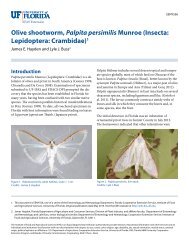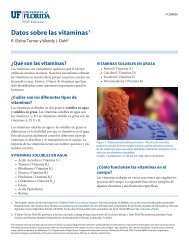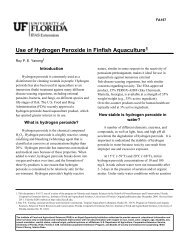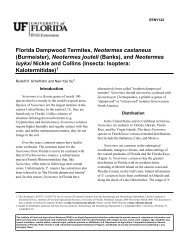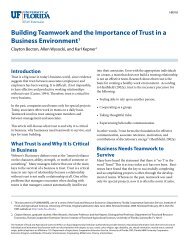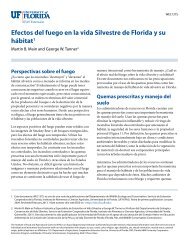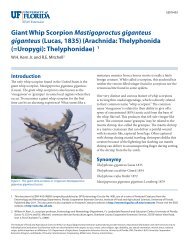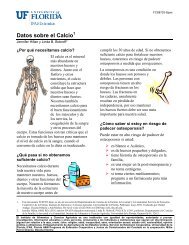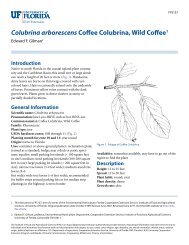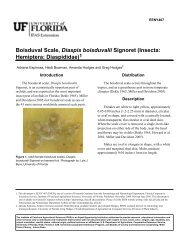Rearing Copepods for Mosquito Control1 - EDIS - University of Florida
Rearing Copepods for Mosquito Control1 - EDIS - University of Florida
Rearing Copepods for Mosquito Control1 - EDIS - University of Florida
You also want an ePaper? Increase the reach of your titles
YUMPU automatically turns print PDFs into web optimized ePapers that Google loves.
ENY697<br />
<strong>Rearing</strong> <strong>Copepods</strong> <strong>for</strong> <strong>Mosquito</strong> Control 1<br />
Jorge Rey and Sheila O’Connell 2<br />
Introduction<br />
<strong>Copepods</strong> are tiny aquatic crustaceans (shrimp, crabs<br />
lobster, and relatives) that are widespread in both fresh and<br />
salt water habitats. They are voracious predators <strong>of</strong> mosquito<br />
larvae, and as such, can be used to control mosquito<br />
production from water holding areas. Copepod cultures are<br />
relatively easy to maintain, but getting the cultures started<br />
requires some ef<strong>for</strong>t and time. Also, some equipment that<br />
may not be readily available to the average home owner<br />
(such as a dissecting microscope) can make life a lot easier.<br />
For effective mosquito control with copepods, it is essential<br />
that you know where the mosquitoes are breeding. Just<br />
because you see larvae in one place does not mean that<br />
that is your major mosquito problem, so if you eliminate<br />
breeding there you may not see a significant change in adult<br />
mosquito populations. Most mosquito control agencies<br />
spend a great deal <strong>of</strong> time, manpower, and money doing<br />
“surveillance” to identify their major mosquito problems<br />
areas. To complicate matters, these “hot spots” can change<br />
with time and physical conditions.<br />
Field Collection<br />
<strong>Copepods</strong> <strong>for</strong> culture start-up can be collected from ponds<br />
ditches and other standing water sources. They can be<br />
collected by quickly dipping a suitable container (a standard<br />
mosquito dipper works well -Figure 1)in the water,<br />
particularly near submerged vegetation. After dipping,<br />
slowly pour out 2/3 <strong>of</strong> the water in the container, and look<br />
at the remaining water <strong>for</strong> signs <strong>of</strong> the copepods (Figure 2).<br />
Even though thay are small, they can be seen swimming in<br />
the collection vessel. If copepods are present, quickly pour<br />
the contents into a clean container, label, and cap securely.<br />
Figure 1. <strong>Mosquito</strong> dippers.<br />
<strong>Copepods</strong> can also be collected by passing water through<br />
two in-line sieves, either by pumping or by scooping water<br />
with a bucket and pouring through the strainers. The top<br />
sieve can be an ordinary kitchen strainer; its function is<br />
1. This document is ENY697, one <strong>of</strong> a series <strong>of</strong> the Entomology and Nematology Department, <strong>Florida</strong> Cooperative Extension Service, Institute <strong>of</strong> Food<br />
and Agricultural Sciences, <strong>University</strong> <strong>of</strong> <strong>Florida</strong>. Original publication date December 2003. Revised April 2004. Reviewed July 2012. Visit the <strong>EDIS</strong><br />
website at http://edis.ifas.ufl.edu.<br />
2. Jorge R. Rey, pr<strong>of</strong>essor; Sheila O’Connell, biological scientist, Entomology and Nematology Department, <strong>Florida</strong> Medical Entomology Laboratory, Vero<br />
Beach, Cooperative Extension Service, Institute <strong>of</strong> Food and Agricultural Sciences, <strong>University</strong> <strong>of</strong> <strong>Florida</strong>, Gainesville, FL 32611<br />
The use <strong>of</strong> trade names in this publication is solely <strong>for</strong> the purpose <strong>of</strong> providing specific in<strong>for</strong>mation. UF/IFAS do not guarantee or warranty the products<br />
named, and references to them in this publication does not signify our approval to the exclusion <strong>of</strong> other products <strong>of</strong> suitable composition.<br />
The Institute <strong>of</strong> Food and Agricultural Sciences (IFAS) is an Equal Opportunity Institution authorized to provide research, educational in<strong>for</strong>mation and other services only to<br />
individuals and institutions that function with non-discrimination with respect to race, creed, color, religion, age, disability, sex, sexual orientation, marital status, national<br />
origin, political opinions or affiliations. U.S. Department <strong>of</strong> Agriculture, Cooperative Extension Service, <strong>University</strong> <strong>of</strong> <strong>Florida</strong>, IFAS, <strong>Florida</strong> A&M <strong>University</strong> Cooperative<br />
Extension Program, and Boards <strong>of</strong> County Commissioners Cooperating. Thomas A. Obreza, Interim Dean
Start-up Cultures<br />
Cultures <strong>for</strong> mosquito control should consist <strong>of</strong> single<br />
species, to assure consistency once an appropriate species<br />
is selected (see below). Gravid females can be easily recognized<br />
because they carry their eggs externally on both sides<br />
<strong>of</strong> their bodies (Figure 4).<br />
Figure 2. Adult copepod.<br />
to capture large debris that may be present in the water.<br />
<strong>Copepods</strong> will be captured in the second sieve which<br />
should be set-up as follows: Obtain a piece <strong>of</strong> 200µm mesh<br />
netting large enough to cover a second strainer; push in the<br />
middle to roughly the shape <strong>of</strong> the strainer bowl and secure<br />
the edges to the strainer with a rubber band (Figures 3 & 6).<br />
Figure 3. Collection strainer.<br />
After filtering through this set-up, either remove the netting<br />
and invert in a container <strong>of</strong> clean de-chlorinated water,<br />
or turn the second sieve set-up upside down over a clean<br />
container and rinse with clean de-chlorinated water from<br />
a squirt bottle. Add water to the collection containers as<br />
needed, cover and label.<br />
Figure 4. Gravid female copepod.<br />
To start a pure culture, set up several small containers<br />
(disposable food containers work well) about ¾ full <strong>of</strong><br />
de-chlorinated water and introduce a single gravid female<br />
in each (Figure 5). This is best done by picking up the<br />
female with a pipette, depositing it in a shallow dish with<br />
de-chlorinated water and then picking her up again and<br />
placing her in the culture container. This minimizes the<br />
chances <strong>of</strong> unintentionally introducing more than one<br />
species into the culture containers.<br />
Water containing chlorine can be de-chlorinated by letting<br />
it sit in open containers <strong>for</strong> several days, by passing through<br />
an industrial charcoal filter, or by treating with chemicals<br />
(e.g., sodium thiosulfate) available at most aquarium stores.<br />
<strong>Copepods</strong> can be reared in pools (plastic kiddie pools)<br />
garbage cans, or other suitable containers. We have found<br />
that aquaria and similar vessels with glass (clear) sides are<br />
not very good <strong>for</strong> rearing copepods. Below we will describe<br />
the procedure using plastic pools, but the steps are the same<br />
regardless <strong>of</strong> the container used.<br />
We recommend that at least two pools (more if possible)<br />
be set-up and maintained at all times. Fill the pools with<br />
2
Pool Maintenance<br />
As the wheat seed decomposes, some will start floating to<br />
the surface <strong>of</strong> the water and should be removed. This can<br />
be done by scooping with an 800µm sieve and discarding.<br />
Sieves can be made by cutting a large hole on a large plastic<br />
lid and gluing the desired size mesh tightly to cover the<br />
hole. Some examples <strong>of</strong> homemade sieves are shown in<br />
Figure 6.<br />
Figure 5. Culture start-up containers.<br />
approximately 80L <strong>of</strong> water from a hose or other suitable<br />
source. If the water contains chlorine, let it sit in the pools<br />
<strong>for</strong> approximately five to seven days to allow any chlorine<br />
in the water to dissipate. It is always a good idea to test the<br />
water in smaller containers with a few copepods to see if<br />
the copepods will survive and reproduce in it. Introduce<br />
several dozen adults and see if immatures (nauplii, Figure<br />
6) are produced. Continue to monitor these containers to<br />
determine if the copepod population is growing after 2-3<br />
weeks.<br />
Once you are satisfied that the water that you are using will<br />
sustain the copepods, introduce at least 200 adults from<br />
the startup dishes into each <strong>of</strong> the rearing pools and place a<br />
standard aquarium aerator in each pool. Add approximately<br />
1000 ml <strong>of</strong> Paramecium culture (see below) and 100 grains<br />
<strong>of</strong> wheat grain. The copepods will readily feed on the<br />
Paramecia, and the Paramecia on the wheat grain. Place the<br />
pools so that they receive light (natural or artificial) <strong>for</strong> at<br />
least part <strong>of</strong> the day, but away from direct sun.<br />
<strong>Copepods</strong> are very hard to see at the beginning <strong>of</strong> the set up<br />
due to the low density. Monitor the pools regularly (every<br />
one or two days) until you are satisfied that the cultures<br />
are viable, that immatures are being produced and that<br />
copepod numbers are increasing. One way to do this is to<br />
take several 500-1000ml water samples from the pools and<br />
checking <strong>for</strong> nauplii, gravid females, and overall copepod<br />
density. When density increases copepods can be seen with<br />
the naked eye throughout the pool, swimming and resting.<br />
At this point, monitoring the cultures every 1-2 weeks<br />
should be sufficient.<br />
Figure 6. Homemade sieves<br />
Pools should be emptied and cleaned at least once yearly.<br />
This is typically done in late spring to avoid extreme<br />
temperatures which could possible increase the chance <strong>of</strong><br />
mortality. Water is siphoned out <strong>of</strong> the pool and through a<br />
200µm (0.02 cm) mesh screen. The contents collected (adult<br />
copepods, copepodites, nauplii, Paramecium, and wheat<br />
seed) are then separated using a 800µm (0.08cm) mesh<br />
sieve to eliminate the wheat seed. The reduced volume <strong>of</strong><br />
water containing the copepods is placed in the pool per<br />
the “initial set-up” instructions. Do not clean all <strong>of</strong> your<br />
pools at once. Make sure that the cultures are thriving after<br />
cleaning a pool, be<strong>for</strong>e your clean the next one.<br />
Cultures<br />
Stock material <strong>for</strong> Paramecium cultures are inexpensive<br />
and can be purchased from any biological supply store (e.g.,<br />
Carolina Biological - http://www.carolina.com/). Add 25ml<br />
<strong>of</strong> the Paramecium caudatum start culture to 1 gallon <strong>of</strong><br />
spring water (acclimate the Paramecia to the spring water<br />
temperature be<strong>for</strong>e adding). Then add approximately 12<br />
grains <strong>of</strong> wheat seed per gallon <strong>of</strong> culture and a small pinch<br />
<strong>of</strong> yeast. Plastic milk cartons (1 gallon or ½ gallon) work<br />
well <strong>for</strong> culturing Paramecium, as well as 5 gallon water<br />
jugs. Wait about two weeks (at room temperature) be<strong>for</strong>e<br />
using. Save about 500 ml <strong>of</strong> each jug, refill with water and<br />
add wheat seed and yeast as be<strong>for</strong>e to start a new culture.<br />
3
Once a year, purchase new start-up cultures and process as<br />
be<strong>for</strong>e.<br />
<strong>Rearing</strong> Notes<br />
• If copepods are cultured outside, they need to be covered<br />
and at least 3 ft. <strong>of</strong>f <strong>of</strong> the ground; ostracods and other<br />
organisms will invade and dominate copepod population.<br />
• Aquaria or similar vessels are not ideal <strong>for</strong> copepod<br />
rearing.<br />
• It is a good idea to set up several pools and to maintain<br />
additional cultures in smaller containers at a separate<br />
location so that new cultures can be started in case <strong>of</strong> loss<br />
<strong>of</strong> original cultures.<br />
Identification and Predation<br />
Efficiency Testing<br />
Ideally, copepods captured in the field should be identified<br />
to species be<strong>for</strong>e using; however, this is very difficult to do<br />
and requires an expert taxonomist <strong>for</strong> reliable identification.<br />
An interactive key to major copepod groups can be<br />
found at: http://www.glsc.usgs.gov/greatlakescopepods.<br />
If specific identifications are not made initially, it is absolutely<br />
essential that cultures remain pure (single species),<br />
and that one continue to attempt to have the animals identified<br />
by an expert.<br />
Be<strong>for</strong>e a time investment is made to rear copepods<br />
<strong>for</strong> mosquito control, you should test the ability <strong>of</strong> the<br />
particular species that you have to accomplish this. Not all<br />
copepods are effective mosquito control agents, and some<br />
are better than others. To test <strong>for</strong> predation rates, you will<br />
need to obtain first instar (newly hatched) mosquito larvae.<br />
The easiest way to do this is to obtain mosquito eggs from<br />
a local mosquito control agency and hatch them just prior<br />
to the experiment. This usually involves simply submerging<br />
the eggs in dechlorinated water. Place 500 newly hatched<br />
larvae in a 200-500ml container half full with dechlorinated<br />
water and add 8-10 adult copepods. Let sit <strong>for</strong> 24 hrs. and<br />
then count how many larvae are left. For effective mosquito<br />
control, a single copepod should be able to consume<br />
approximately 30 first instar larvae per day or more. Ideally,<br />
this experiment should be replicated several times.<br />
4



